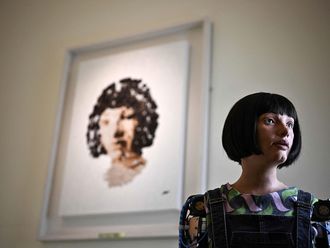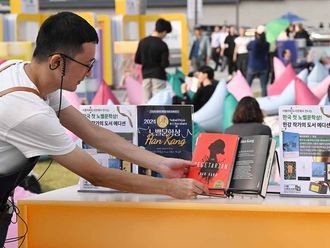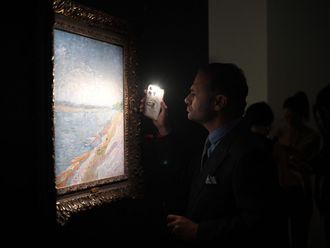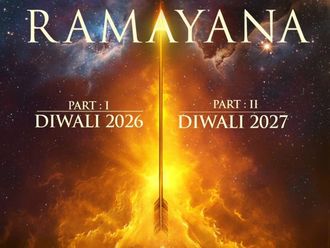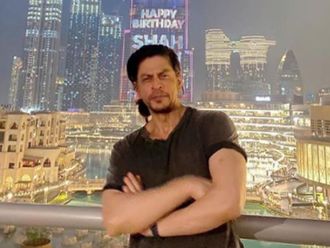In a city that has changed in the most dramatic ways with a pace and panache unrivalled in modern history, there are some places however that have almost stood still and allowed the incoming wave of time to wash over them but briefly. The Spice Souq in Deira, in the heart of old Dubai, is one of them. The very name takes us back in time to the Old Arabia of the One Thousand and One Nights with its winding alleys, exotically robed figures and rare goods and spices arriving from faraway places by dhow and camel caravans.
A wonderfully different experience, the Spice Souq is a visual pick-me-up with narrow ribboned streets that seem to have trapped the hurry of time. These streets are studded with bags and bags of spices spilling over, colour, texture, volume rivalling each other in every pod and petal.
There are mounds of saffron, ruby red dry chillies, ebony black pearls of pepper, rustic brown of star anise... that slither and pop under your feet and crackle in your hands.
The sun sieves itself into uneven patches through the alleys, over the faces and figures that in the souq who are intrinsic to its unique character.
But it's the heady scents of the Spice Souq that are probably its most stunning feature. It's an aroma you want to breathe in, breathe out, wear, pick notes from, savour and even bottle.
History and aroma: a heady bouquet
"The first time I visited the Spice Souq was in 1966-67 when I was five or six years old," reminisces Rashad Bukhash, Director, Architectural heritage Department, Dubai Municipality. "It was like a wholesale market then - it was a wonderful experience for a child, exotic and fascinating. The smell of the place was special... it still brings back nostalgia. It excites the senses, and remains one of my favourite places to visit. Sometimes I go there not to buy anything, but just soak in the atmosphere, smell the spices and indulge in a bit of nostalgia! I also like to browse through the shops, finding out what the different spices are meant for, the medicinal herbs, just learning about them.
"I always get the feeling of being in some of the old Islamic cities like Damascus, Cairo or Istanbul when I visit the souq. Take Aleppo, for instance. The souq there is similar, though ten times larger."
It is a place that offers you the larger picture of the smallest and most expensive pleasures of life.
Take saffron. It is everywhere. In the labyrinthine Spice Souq, saffron is king. As is any other spice you can ask for. Saffron is the dried stigmata of the crocus flower. Considering a crocus has only three stigmas, each of which has to be harvested by hand - it is mind boggling to see a kilo of saffron, much less a whole shop full of jars of the stuff. Over half a million stigmas are required to make a kilo of saffron, according to an Iranian shopkeeper. In fact, most of the merchants in the Spice Souq are from Iran. The reason apparently is that many Iranian ports are within a two-day dhow ride across the Arabian Gulf.
A lane garnished with memories
Mashallah Gharibi has been manning a shop in the spice souq for the last 45 years, perhaps the oldest surviving merchant in the souq. He doesn't remember any of his contemporaries.
"You see only youngsters here now," his creased face wrinkling up even more as he grins. He first came to the Spice Souq to work in a cafeteria, but almost immediately found an opening in a shop that sold medicinal plants and herbs.
He remembers there were hardly any buildings in those days. "It was open, the creek was next door, but even the smell of the fish could not affect the wonderful smell of our spices!" There was no electricity and running water. "We had to light lamps when it became dark. But life was good," he reminisces. "The late Shaikh Rashid Bin Saeed Al Maktoum, former Ruler of Dubai, used come here some days in the evenings. He would come around 10pm and leave around midnight. He would sit under a tree over there." He points to a spot towards his right where the parking area of the souq now stands.
The shops came up one by one. "There were only four main shops that sold spices and medicinal herbs, all run by Iranians," he recalls. "Now there are around 50 of them. I just can't believe it!"
Those days there were very few vehicles; the only ones were Land Rovers. "Mostly Arabs buy spices from here. They make bisar (a mix favoured by Emiratis) from these spices. But nowadays youngsters are not so fastidious, so I make the mixes and they are popular too," he says pointing to the rows of ground spices in bottles all neatly labelled. "We were happy in those days, things were cheap. Now the returns might be more but the costs too have spiralled."
Though the Spice Souq goes back to around 1850, the expansion began after 1903 when trade increased and Dubai became a major player, says Bukhash. "More shops were built in Bur Dubai and Deira, and trade increased with India, Pakistan and East African countries such as Somalia, Ethiopia and Kenya. That gave the right fillip to the Spice Souq. The number of shops grew during the 1970s."
Making it to the dining table
From the souq to the kitchen, it was a short journey for these foreign spices, says Bukhash.
"A lot of our traditional dishes are now flavoured with the spices that have become available through the souq. The rice, the curry, biryani, are all dishes that we have adapted. Certainly, if you compare our food from 1900 before the spices became so popular, and now when you use them in almost everything, then they have influenced Emirati cuisine very heavily. It has even affected Oman. Many of them come here to buy spices."
Chef Khalil Mustafa, of the Dubai World Trade Centre can vouch for the difference spices have made in Emirati cuisine. Mustafa says most of the spices available here have found their way into the Emirati cuisine. "The main spices used in Emirati cuisine are from India and Pakistan."
The most popular are cardamom, cumin and coriander seeds, says Mustafa who specialises in Emirati cuisine and has co-authored a book, A Culinary Journey: Celebrating 30 Years of Our History, published by the Dubai World Trade Centre. "I would say the Emirati mix would be something like 60 per cent of cumin and coriander seeds, and 40 per cent of other spices such as cloves, nutmeg, cardamom, cinnamon sticks, aniseeds and so on. Saffron too is important for many dishes."
He goes down to the Spice Souq every three months to stock up on spices. "The variety is amazing, and sometimes you come across spices that you've never seen before."
Mustafa has done some research on Emirati cuisine. He's of the opinion that Emirati households began using spices at least half a century ago.
"I met an Emirati chef who used to work in some houses, and he told me he'd been using them for the past 30 years, and he was certainly not the first one.
"The spices we use for cooking mainly come from India," says Mustafa. "It has to do with the trade between the two countries that has flourished since long, and now the spices are so much a part of our cuisine here that people have started making their own mixtures according to their tastes.
"I find on my expeditions there that there are many families in Dubai who visit the market regularly to choose their spices, wash and dry them in the sun for a few days and then get them powdered - this is the special mixture called bisar."
Turmeric is a spice that is used on a daily basis in Emirati kitchens, other than bisar. The fishes that are cooked for lunch are marinated in turmeric, says Mustafa.
"The reason why spices are so popular I would say is because of the variety of people living in Dubai. They have different tastes honed in their native land, and here they find the best spices from around the world, and a wide variety of cuisines to inspire them. It begins as an experiment and before you know it, it's a passion!"
According to Mustafa, the Spice Souq has brought more flavour into Emirati cuisine. "It has inspired cooks to create their own mixtures to spice up the dishes. I see it happening every day. People are beginning to experiment more and more. Every day when I feed my customers, I have some who come up and suggest different combination of spices for certain dishes they like. I would say it has expanded their olfactory range.
"The kind of influence spices have over Emirati cuisine can be gauged from the fact that other Middle Eastern cuisines do not employ much spices at all whereas Emirati cuisine uses them in spades."
Variety is definitely the spice
Mustafa also credits the huge mix of nationalities in Dubai with the changing the face of Emirati cuisine. "Rice was not a staple food here, but now it has become almost indispensable," he points out. "It is now the staple lunch and dinner for Emiratis."
Mustafa sees Emirati cuisine growing in popularity. "Nice smell and strong flavour is the hallmark of Emirati dishes, among other Middle Eastern cuisines whether Jordanian, Syrian or Lebanese.
We cater to around 3,000 customers on a daily basis, so that I think that proves Emirati cuisine is popular."
Mustafa has a word of advice for those who want to try their hand at Emirati cuisine: "If you get the Emirati bisar right then all the other dishes will be child's play. That's why we put it at the beginning of the book that contains 30 recipes!"
According to Mustafa, spices are crucial to cooking Emirati dishes. "There are a few [dishes] you can cook with just salt as a flavouring but they wouldn't be as good," he says. "[Spices] are the life of Emirati cuisine."


